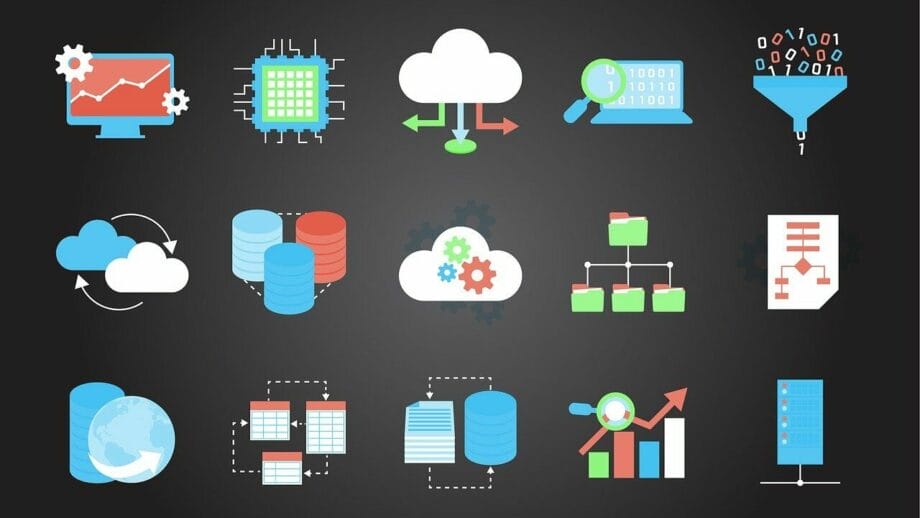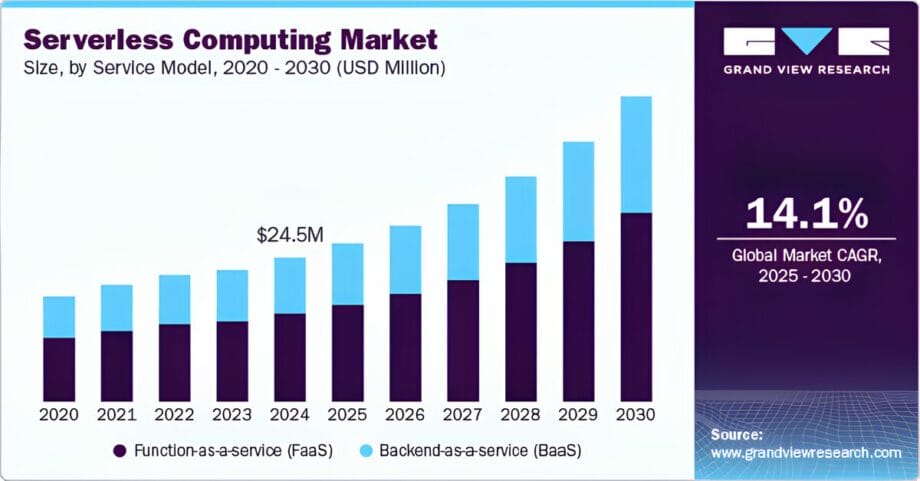Once the heart of enterprises, legacy software systems are now slowing things down. Why is this so? They run on outdated frameworks and technologies that can’t meet today’s needs, such as rapid growth, flexibility, and cost savings.
So, what happens to these old systems that companies have used for years? They are transforming. According to the Flexera report, more than 70% of businesses are considering digital transformation a crucial initiative. Modern application architecture provides better and faster business solutions.
Modern businesses are relying on serverless architecture to build apps quickly, cost-effectively, and in the cloud. But can aging systems withstand a serverless-first world? Or are they ready to be replaced? This blog will answer these questions. But before that, let’s get to know serverless architecture.
What is Serverless Architecture?
Serverless architecture lets developers build and run applications without worrying about managing infrastructure. On the other hand, the cloud provider takes care of setting up servers, scaling, fixing bugs, and managing resources. So, teams can just focus on writing code and solving real business problems.
Unlike older methods or even containers, serverless computing grows with your app and only charges when it runs. It uses tools like AWS Lambda, Azure Functions, or Google Cloud Functions for rapid deployment.
In fact, the global serverless computing market was valued at $24.51 billion in 2024 and is expected to grow at a 14.1% CAGR from 2025 to 2030.
This data speaks volumes. For businesses seeking legacy software modernization using serverless, this means lower costs, faster updates, and apps that are always ready to run.
How Does the Serverless Architecture Function?
Serverless architecture is based on the Functions-as-a-Service (FaaS) model. This means cloud platforms can run software code without setting up a complete infrastructure. Additionally, developers use serverless to write code for particular functionalities. That’s why many cloud service providers now offer FaaS.
API Gateway helps guide user requests to the correct function. Here’s a quick breakdown of how serverless computing works:
- Instead of building the whole app simultaneously, developers write small blocks of code called functions, each for a specific task.
- Then, they set up an event. For instance, a user clicking a button or an email coming in that will trigger the function.
- When the event happens, the function is triggered.
- After comprehensive testing, the team deploys the function, which triggers on their cloud account.
- When the function is needed, the cloud computing service provider either uses a running server or starts a new one to handle it.
- The output of that function is then sent back to the app for the user to see.
Serverless architecture isn’t something new. It’s been around for more than 10 years. In 2014, Amazon launched AWS Lambda, one of the first popular FaaS (Function-as-a-Service) platforms. Since then, it has become a favorite tool for many developers to build serverless applications.

The Pain Points of Legacy Applications in the Modern Era
Legacy software applications are hard to deal with. They are monolithic, use outdated technology, and don’t integrate well with new tools. This makes them slow, costly, resistant to change, and complicated to upgrade. Legacy systems deal with several issues, which are mentioned below:
- They have limited scalability and can’t handle heavy or sudden traffic spikes.
- Legacy apps have expensive operational and licensing costs.
- Additionally, they are incompatible with the latest cloud services such as IaaS, PaaS, and SaaS.
- Outdated software cannot integrate modern APIs, such as Amazon S3 REST API, Dropbox API, AWS APIs, and Google Drive API.
- One significant pain point is the slow innovation cycle. Due to their rigid architecture, these apps make it difficult to roll out new features quickly.
For businesses that want to scale and go digital, these old systems pull them back. They drain resources, time, and money, and can even cause cybersecurity threats.
Business-Centric Benefits of Serverless Architecture
Serverless architecture offers tangible benefits for organizations bogged down by legacy constraints. Here’s how it directly addresses those issues:
Serverless architecture offers several advantages over contemporary cloud-based or server-driven infrastructure. Businesses can consider using cloud-native serverless computing to drive growth, sustainability, and build future-ready solutions.

Here’s how legacy application modernization with serverless architects assists businesses:
1. Elastic Scalability
Your app can handle traffic spikes through auto-scaling functionality. No need to add servers or make changes manually. It dynamically adjusts resources and scales up or down as per the demand.
2. Cost Efficiency
The serverless architecture uses a Pay-per-use model that reduces infrastructure costs. There’s no need to keep paying for idle servers or unused resources, which helps save money. Serverless systems also demand financial discipline and real-time insights to handle fluctuating costs.
3. Faster Iteration
Serverless is event-based. So, you can build small, focused pieces of code (called functions) and update features quickly without having to wait for resources to be provided, which speeds up time-to-market.
4. Maintenance-free Infrastructure
You don’t need to set up, maintain, or patch servers. The cloud computing providers take care of everything behind the scenes. This helps your team reduce downtime and speed up updates.
These serverless benefits help companies cut waste, move faster, and build smarter apps. It’s a great way to clear out technical debt and move into the future with speed and ease.
Choosing the Right Serverless Migration Strategy
Moving from legacy systems to serverless computing is not a one-size-fits-all option for every business. Selecting the correct serverless migration roadmap is crucial. One mistake can collapse the entire IT ecosystem and damage its reputation.
You must pick the best path based on your application category, goals, and market risks. There are three main ways to migrate to a serverless architecture.

- Refactor: Refactoring is the procedure of restructuring some parts of your outdated application into smaller, serverless functions while keeping the main features as they are. For example, you could turn a user login system into a serverless function but leave the database setup untouched.
- Rebuild: Rebuild means redesigning and re-creating an app or system using serverless tools and methods. For instance, instead of fixing an outdated inventory system, you build a new one from the ground up on AWS Lambda or Azure Functions.
- Replace: Replacing means swapping the legacy software with cloud-native solutions or SaaS-based solutions. For example, you might stop using a custom CRM and switch to a SaaS tool like Salesforce or HubSpot.
Each choice depends on how complex your app is, how important it is to your business, and how much change you’re ready for. That’s why conducting a cloud migration assessment is essential to move forward.
Challenges of Legacy Application Modernization with Serverless Architecture
While serverless platforms offer many benefits, switching to them can still bring many legacy application modernization challenges. Here are some common roadblocks you might face:
- Data Gravity: Data gravity is the characteristic of data and its related systems to be present together. Heavy legacy data systems can be complex to move or break apart. This can lead to increased latency, which poses a significant challenge to legacy modernization efforts. For example, a large customer database may not work well outside its current setup.
- Cold Starts: Functions can take time to initialize, impacting latency. Organizations can face this challenge while migrating to advanced technologies or environments. It occurs due to a lack of knowledge, infrastructure, and data in the new system. Cold starts can cause delays, like a long wait when loading a page for the first time.
- Vendor Lock-in: Another legacy app modernization challenge includes vendor lock-in. Your app might depend too much on one cloud provider, making it difficult to switch to other providers or integrate new tech as they gain traction. For example, using AWS-only tools may make it hard to switch later.
- Monitoring and Debugging: Legacy systems can be tricky because they are complex, outdated, and often lack clear records. Regular tools might miss minor issues, and fixing bugs can be tough when no one fully understands how the system works or when the problem doesn’t always happen the same way.
- Compliance Hurdles: Legacy software generally lacks resilient and AI-powered features, which are necessary in today’s digital age. This makes them vulnerable to cyber threats and breaches. Most importantly, your outdated system may not have the latest firewalls, 2-factor authentication, access controls, modern APIs, and compliance with GDPR and HIPAA.
To solve these problems, businesses should review their app setup, use clear security plans, and add tools that help monitor everything. That way, moving to modern application architecture will become smoother and safer.

Best Practices for Legacy System Transformation with Serverless
If you want to modernize legacy apps using serverless architecture, you can follow these tried-and-tested practices:
- First, assess if your current code and tools are ready for a transition. For example, you might find that older parts of your app are too tightly linked to be separated.
- Next, pick the modular components that work independently and try moving those first. A good example is shifting the login feature or payment process to serverless.
- Then, use simple CI/CD tools like GitHub Actions to help your team build and launch code faster.
- Also, add tracking tools like AWS CloudWatch so you can see how each function runs.
- Finally, make sure your DevOps team works closely, so new updates go live quickly and smoothly.
By implementing this legacy system transformation strategy, your business can slowly migrate from outdated systems to faster and more flexible serverless apps.
The Future of Modern Application Architecture
The digital topography is moving quickly, demanding apps that are not only dynamic but also intuitive, AI-assisted, and future-ready. With a sustainability-led design that focuses on energy-efficient codes, the future of modern application architecture looks promising.
Let’s look at future trends that will impact application architecture:
- Edge Computing: Edge computing in the future will move data and apps closer to users. This will cut delays and speed things up. It can help websites, games, and apps work faster, even in remote or busy places.
- AI/ML-Driven Platforms: AI/ML tools can help apps learn and act smarter. They can make real-time decisions, spot trends, or suggest actions, like AI chatbots, fraud alerts, or smart search results.
- Event-Driven Architecture: This setup lets apps respond to real-time actions or events. For example, when you click “buy,” it automatically starts a payment and shipping process, making apps quicker and more flexible.
Final Thoughts

Serverless architecture is a big step forward, but it is not the answer for everything. It helps with scaling, saves money, and speeds up app building. Still, some legacy systems may stick around for niche roles. So, what should you do? Start by auditing your current systems. Look at apps that cost too much to run or have security issues.
Time is moving fast. If your business uses slow, outdated tools, you may fall behind others who are already leveraging legacy application modernization services. Serverless isn’t a maybe anymore, it’s a must for those who want to grow.







